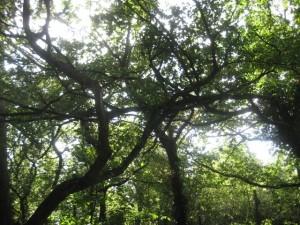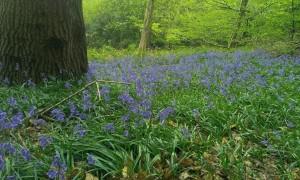Ancient woodlands and BAP woodlands; why they are special.
Biodiversity offsetting can be a very useful way of mitigating for new development. At Landvision, we feel that there are some cases where offsetting can be used to great effect to mitigate and to enhance landscape and ecology. Despite what the UK government say, we feel there are also some instances, however, when biodiversity offsetting cannot be used. One such instance is ancient woodland. The Woodland Trust have mounted a petition to save ancient woodlands.
Biodiversity Strategy 2011 – 2020 and UK BAP.
The Biodiversity Strategy of 2011 and UK Biodiversity Action Plan and associated Habitat Plans, enable us to protect the unique habitats of ancient woodlands. The Biodiversity Strategy of 2011 and UK BAP recognize that broad leaved, mixed woodlands support almost twice as many species of conservation concern than any other habitat, such as chalk grassland or even heath land. What in particular makes ancient woodlands special and why preserve them? Biodiversity offsetting simply cannot replace ancient woodland. Only 2% of our UK ancient woodland remains intact.

Ancient woodlands and Biodiversity Offsetting.
Frequently, ancient woodlands were located on the farthest edges of Parishes and towns, left over pieces of land, from previous activities because they were too wet or too steep to be cultivated. This has resulted in the irregular outlines and wavy edges of many ancient woodlands. In the High Weald of Kent and Sussex, they are often called ghylls or gills after the steep sided valleys that they are located in. The plants that these woods contain are characteristic of ancient woods and they also often contain bryophytes or lichens. This is due to their undisturbed nature, their management may not have changed much in hundreds of years. One of the reasons why they are irreplaceable, is because they contain a unique set of plants, soils and fauna that are characteristic of ancient woodlands. The loss of these ancient woodlands cannot be offset by planting of new woodland. It is simply impossible to offset or recreate an ancient woodland- just as it is impossible to repaint a master piece. Despite their scarcity though, some ancient woodlands are under threat. Perhaps one of the biggest threats to ancient woodlands, is through poor management and neglect.
Management for ancient woodlands; as an offsetting tool.
At Landvision, we understand how to manage your sites to enhance biodiversity. This management can also help to increase the CO2 take up of the woodland We can help and advise you on how to offset biodiversity loss from some habitats. These habitats may be scrub or secondary woodlands; these woods differ from ancient woodlands, which must be protected. We will also be able to come to site to advise you on how to maximise the biodiversity of an ancient woodland, by sensitive management, saving you both time and money.
Knowing when to undertake biodiversity offsetting and when to do certain woodland operations can help to keep you on the right side of Wildlife & Countryside Law by taking care of protected species. It will also mean that you can program works in to an appropriate time of year, avoiding costly delays. For advice on how to make the most of your woodland and natural habitats on your site, contact Landvision.
A rare and rich resource under threat.
Protecting and managing ancient woodland is a vital part of our role. Keeping woods safe as a resource, by restoring and maintaining levels of biodiversity means that we can’t afford to lose these woods. Ancient woodland is under threat on a daily basis from man’s activities; fly tipping, dumping and neglect, plus lack of sustainable woodland management. So why can’t ancient woodland loss be offset? Ancient woodland has unique plant and animal assemblages. These communities cannot be recreated by the mitigation schemes of planting of new trees or the creation of new habitats from scratch. Ancient woodlands are timeless places of great antiquity and are not commonly found or widespread as habitats. Instead, they are becoming more fragmented and more vulnerable to pressures from man’s activities. What other characteristics do these woods have?

Bluebells, Wood Anemone and Ransoms; ancient woodland indicators.
Ancient woodland is home to more threatened species than any other habitat. One of the things that is so special about ancient woodlands is their plant communities. These are unique, as the plants which are characteristic of these ancient woods are slow colonisers. Often the woods have a highly distinctive character, with unusual distributions of wild flowers, which can be traced back to woodlands on these sites hundreds of years ago. These plants might include wood anemone, yellow archangel and wild garlic or ransoms. Bluebells are an ancient woodland indicator. These species are protected and should not be dug up or removed from ancient woodlands.
Other signs of ancient woodlands, include Bronze and Iron Age earthworks, ancient park boundaries, ridge and furrow, park pales and wood banks. Often, mossy old coppice stools, large mature Oak standards are found in ancient woodlands. Archaeological remains of ancient activities, such as smelting and charcoal burning, have left hollows and lime kilns as round pits in these unique woodlands. The communities of plants, trees and bryophyes/lichens growing within ancient woodland are unique to each wood. They vary according to the different soils and conditions such as the micro climates within and between ancient woodlands. This is why each ancient woodland is impossible to offset as each individual woodland is irreplaceable. Biodiversity levels are extremely high and the species composition of these woods is unique; for this reason and for their archaeological and historical value as links to the past management of the woods, they cannot be offset and need to be preserved.
For advice on how to make the most of your woodland or the natural habitats on your site, contact Landvision.
If you need to discuss a project, give us a call on 01892 782200 or visit our Contact page
